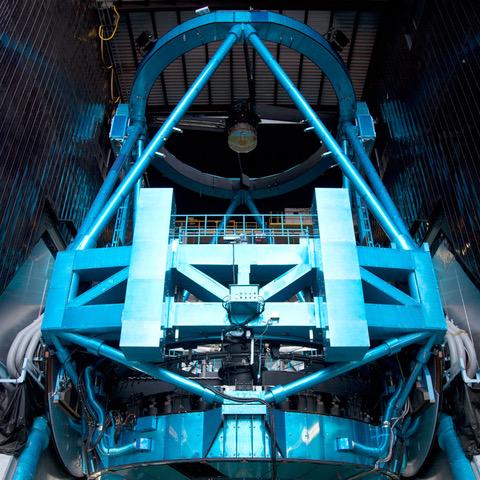Subaru Telescope helps pinpoint origin of ultra-high energy neutrino

Subaru Telescope. Credit: NAOJ
On September 22, 2017 the IceCube experiment at Amundsen Scott station in Antarctica detected an ultra-high energy neutrino coming from outer space and was able to determine the direction it came from to within about 1 degree using the system developed by researchers at Chiba University.
While narrow compared to the entire sky, 1 degree still contains many possible candidates for the source object.
OISTER, a network of Japanese university telescopes, collaborating with the 8-m Subaru Telescope in Hawai?i, performed follow-up observations to determine the source of this enigmatic neutrino. They found that an object named TXS 0506+056 was acting peculiarly: shining 3 times brighter than normal and fluctuating more than usual.
TXS 0506+056 is a blazer, superheated matter releasing abundant radiation as it slowly spirals down into a supermassive black hole.
A quick calculation showed that the odds of two freak occurrences (the ultra-high energy neutrino and a flaring blazer) occurring so close together in time and space by pure chance is effectively zero, unless the two phenomena are related. Therefore TXS 0506+056 must be the source object of the neutrino.
Prof. Michitoshi Yoshida, the Director of Subaru Telescope comments, “We congratulate all members of the IceCube and OISTER teams on this important discovery.
We are proud that the Subaru Telescope with its deep observation capability could play a small role in this discovery. In this era of multi-messenger astronomy, collaboration between different observing facilities will be increasingly important. We look forward to working with this team more in the future.”
Media Contact
All latest news from the category: Physics and Astronomy
This area deals with the fundamental laws and building blocks of nature and how they interact, the properties and the behavior of matter, and research into space and time and their structures.
innovations-report provides in-depth reports and articles on subjects such as astrophysics, laser technologies, nuclear, quantum, particle and solid-state physics, nanotechnologies, planetary research and findings (Mars, Venus) and developments related to the Hubble Telescope.
Newest articles

Pinpointing hydrogen isotopes in titanium hydride nanofilms
Although it is the smallest and lightest atom, hydrogen can have a big impact by infiltrating other materials and affecting their properties, such as superconductivity and metal-insulator-transitions. Now, researchers from…

A new way of entangling light and sound
For a wide variety of emerging quantum technologies, such as secure quantum communications and quantum computing, quantum entanglement is a prerequisite. Scientists at the Max-Planck-Institute for the Science of Light…

Telescope for NASA’s Roman Mission complete, delivered to Goddard
NASA’s Nancy Grace Roman Space Telescope is one giant step closer to unlocking the mysteries of the universe. The mission has now received its final major delivery: the Optical Telescope…



